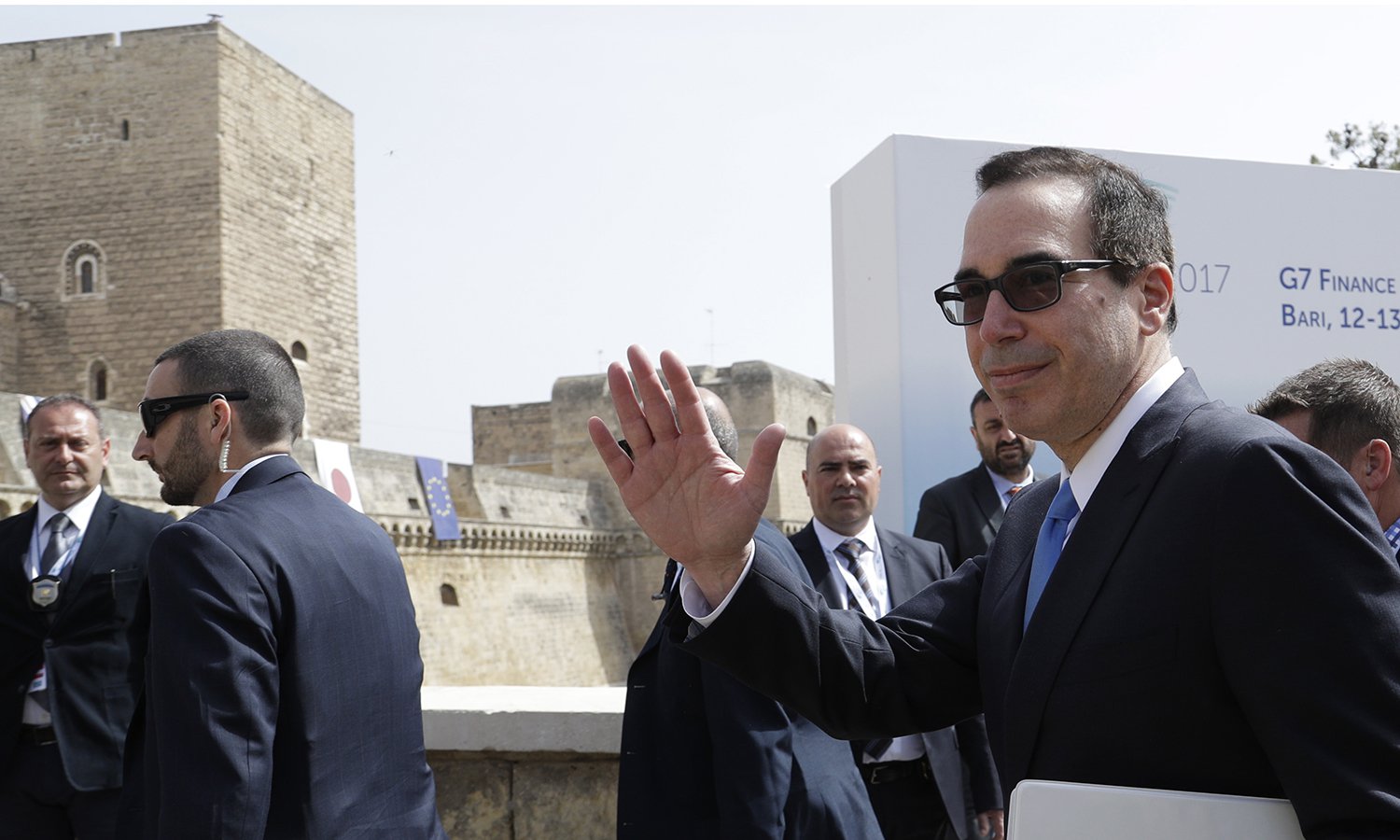With US President Donald Trump’s barrage of executive actions since taking office, it would be easy to overlook a memo indicating he wants to scrap a system set up after the 2008 financial crisis for handling failures of large banks.
And indeed, the directive to Treasury Secretary Steve Mnuchin on the topic, issued late last month, passed with scant comment.
It’s nonetheless reverberating on Wall Street and among finance chiefs across the Group of Seven (G7) wealthiest nations because of its potential effect on a painstaking international effort to rein in the risk that large, systemically important financial institutions pose to the economy if they fail.
“It would eliminate the ability to conduct international coordination and dramatically increase systemic risk,” said Michael Barr, former assistant secretary for financial institutions at the US Treasury between 2009 and 2010.
Mnuchin was urged during a two-day meeting of G7 finance ministers and central bankers in the port of Bari, in southern Italy, not to break the global consensus on financial regulation.
Trump’s memo orders the US Treasury secretary to review the effects of a Dodd-Frank reform law provision creating “orderly liquidation authority,” the power to wind down a collapsing financial institution deemed likely to threaten financial stability. The liquidation authority was the US administration’s principal legislative response to the catastrophic effects on credit markets in the wake of investment bank Lehman Brothers’ infamous collapse in 2008.
The bankruptcy mechanism has been criticized by Republicans, who say it gives regulators too much discretion to pick winners and losers among junior and senior creditors, which, they argue, can then turn into political horse trading. They also contend that the system enshrines too-big-to-fail by allowing for taxpayer-funded bailouts of large creditors of a failing big bank. Trump’s measure seeks to block the Dodd-Frank bankruptcy system, although a Treasury Department review would need to be conducted first, with a deadline of October.
Nevertheless, Wall Street financiers are expecting that review to put a spotlight on legislation making its way through Capitol Hill, included in a broader banking relief package called the Financial Choice Act, which seeks to replace the liquidation authority with an approach based on revisions to Chapter 11, the existing US bankruptcy code that leaves it up to the courts to prioritize creditors.
The package includes a provision prohibiting derivatives counterparties from terminating their swaps contracts immediately at the beginning of an insolvency proceeding. The stated goal of the measure is to ensure that a historic “run on derivatives,” like the one that occurred upon Lehman Brothers’ bankruptcy, thereby helping to drive the 2008 crisis, doesn’t happen again.
However, former top bank officials and overseas regulators point out that the post-crisis system also includes a provision delaying the termination of derivatives that has the same effect.
And, probably more important, they contend that a key aspect of the liquidity authority is that, unlike the Chapter 11 legislation, it would initially employ taxpayer funds to dismantle a failing big bank. (This is where the Republican law makers see bailouts.) The funds would be used to make payouts, for example, to systemically important creditors, presumably other big banks and financial institutions on the verge of failure. Taxpayer dollars, based on the statute, would later be recouped through a sale of assets or a fee on big banks with more than US$50 billion in assets.
“It’s not a bailout,” said Barr, the former assistant secretary under the Obama administration. “The recoupment is automatic. The Federal Deposit Insurance Corporation [FDIC] gets paid back either from a sale of assets of the firm or an assessment on the industry.”
A number of academics say they are supportive of the congressional bankruptcy reform effort — but only if it is a complement to the Obama-era liquidation system.
Columbia Law School Professor John Coffee argues that a key difference between the two approaches is that under the current liquidity authority, regulators have the power to shut down a big failing bank. Alternatively, the bankruptcy code would leave the closing decision to the bank.
“It would be shut down when the bank totally runs out of money,” Coffee said. “Lehman was shut down on the last day and it was flat broke and could not continue to operate. We’ll have bigger losses [without the liquidity authority] because there will be a longer period of insolvency.”
In addition, Coffee contends that if the current authority is eliminated, a struggling bank would lose access to vital liquidity, the Achilles heel of banks.
“Most large bank failures are caused by liquidity failures rather than insolvency,” Coffee said.
When it comes to limiting systemic risk in the aftermath of the crisis, folks on Wall Street and regulators, particularly in the United Kingdom and United States, agree that international cooperation is critical. Roughly two-thirds of the non-US assets for the top eight American banks are located in the United Kingdom, which means collaboration between these two countries is vital.
That’s probably why the Trump executive order, even if it does not survive the Treasury review, has already sent shockwaves across the Atlantic.
Consider that Andrew Bailey, head of the UK Financial Conduct Authority, recently suggested that foreign regulators would lose confidence in how the United States deals with banking crises if it eliminated the liquidity authority. “Frankly, if we were left with a bankruptcy code-only solution there it would be worrying,” Bailey said. “If that got disrupted badly, and I hope it won’t, I really hope it won’t, that would be the element that I think would be problematic internationally.”
Across the Atlantic, the sentiment is similar. Barr, now a law professor at the University of Michigan, suggests that agreements between the US and UK regulators would “blow up” if the liquidity authority was eliminated.
“The UK, the FDIC and Bank of England have an agreement that says, ‘this is how a global financial institution based in both countries should be resolved,’” Barr said. “The Financial Choice Act would undo that agreement. It would eliminate the ability to conduct international coordination and dramatically increase systemic risk.”
Former International Monetary Fund chief economist Simon Johnson, now an MIT Sloan School of Management professor, argues that eliminating the liquidity authority and replacing it with the bankruptcy bill would make it impossible for the United States and the United Kingdom to cooperate in a big bank failure situation. He envisions a Lehman-like scenario unfolding. “There would be a big scramble in different jurisdictions to grab collateral and protect certain creditors in their jurisdiction because they don’t know what is going to happen,” Johnson said.
Even so, the Obama-enacted liquidation system isn’t going to disappear immediately following the memo. The Treasury study — a first step ordered by the Trump memo — will take a look at whether the liquidity authority structure “leads market participants to believe a financial company is ‘too-big-to-fail.’”
The review will then be parsed by law makers from across the poltical spectrum.
In a period of rapid and sometimes unpredictable shifts in Washington, it can be hazardous to try to forecast machinations on Capitol Hill with too much precision.
But there are signs that legislative efforts to repeal the liquidity authority could suddenly speed up in a way that sidesteps opposition.
An obscure budget reconciliation process, created by the Congressional Budget Act of 1974, could be used to circumvent Democratic resistance and pass a bill repealing the liquidation approach. It would allow Republicans — who have 52 Senate seats — to approve the legislation with only 51 votes. As a result the move wouldn’t need a filibuster-proof 60 votes to obtain approval. The measure, backers in Washington argue, might qualify for the budget tactic because of the liquidation authority’s estimated potential cost to taxpayers.
For now, the legislative agenda of Congress and the White House is dominated by tax reform and Obamacare repeal, and clouded by rows over national security. Bank regulatory relief is considered a distant third legislative priority in their view.
However, it is not out of the question that if backers see an opening, repeal of the liquidity authority, and the accompanying global ramifications, could quickly become a reality while attention is elsewhere.



